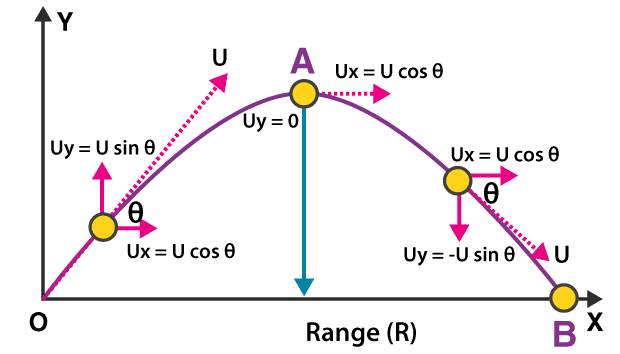Topic Content:
- Time of Flight
If an object is projected with a velocity, U, and at an angle of inclination θ, with the horizontal from which it was projected, the vertical component of the velocity Uy, is U sin θ, while the horizontal component Ux, is U cos θ.

Initial horizontal component: Ux = U cos θ
Initial vertical component: Uy = U sin θ
Let us consider when the object is moving up in the y direction
When the object is moving up in the y direction, the acceleration = -g, because gravity is acting downwards.
The body moves along a parabolic path, reaches a maximum height and returns back down to the ground. When it reaches the ground again its vertical displacement is 0.
∴ as it hits the ground, y = 0
Using: \( \scriptsize s = ut \: + \: \normalsize \frac{1}{2} \scriptsize at^2 \)
s = y = 0
U = Uy = U sin θ
a = -g
T = t
We can use these values to calculate the time (T) it takes to finally hit the ground.
i.e. Time of flight, T = t
let’s substitute all the values into the equation: \( \scriptsize s = ut \: + \: \normalsize \frac{1}{2} \scriptsize at^2 \)
⇒ \( \scriptsize 0 = Usin \theta (T)\: – \: \normalsize \frac{1}{2} \scriptsize gT^2 \)
T = 0
OR
⇒ \( \scriptsize Usin \theta (T) = \normalsize \frac{1}{2} \scriptsize gT^2 \)
⇒ \( \scriptsize Usin \theta = \normalsize \frac{gT^2}{2T}\)
⇒ \( \scriptsize Usin \theta = \normalsize \frac{g\not{T}^2}{2\not{T}}\)
⇒ \( \scriptsize Usin \theta = \normalsize \frac{gT}{2}\)
⇒ \( \frac{gT}{2} = \scriptsize Usin \theta \)
⇒ \( \scriptsize T = \normalsize \frac{2Usin \theta}{g} \)
Alternative Method:
A second method is to consider the vertical velocity at the maximum height.
At the maximum height, the final vertical velocity of the projectile is 0, v = 0
using: v = U – gt
0 = U sin θ – gt
You are viewing an excerpt of this Topic. Subscribe Now to get Full Access to ALL this Subject's Topics and Quizzes for this Term!
Click on the button "Subscribe Now" below for Full Access!
Subscribe Now
Note: If you have Already Subscribed and you are seeing this message, it means you are logged out. Please Log In using the Login Button Below to Carry on Studying!



Responses